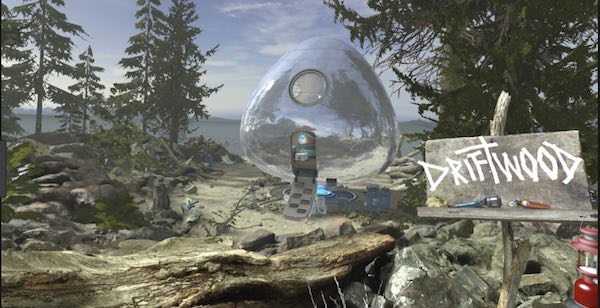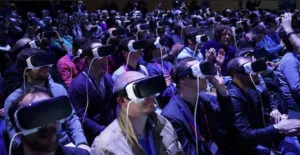For a full disclosure, I do not have the answer to the above question and if I would, I would make billions by not sharing it with the world. Well, this is true for everyone in the AR/VR industry, otherwise I wouldn’t write an article about this topic, instead I would write an article about the latest record adoption figures of AR/VR devices.

What I want to do is ask some questions that the industry has to answer if we are ever to see the ultimate success of any type of ‘Reality‘ technology.
Are we impatient?
Since the market development of the smartphone, we have seen adoption cycles that were unheard of a few decades ago. With the smartphone we were looking at the replacement of the cell phone with an established install base. It was clear from the beginning who the first smartphone adopters would be. When the smartphone adoption rates continued to go above and beyond the forecasts we were surprised and gladly rode the smartphone train.
When the e-reader (remember the Kindle?) broke all published forecasts including the one by yours truly, we saw another increase in adoption rates that changed our minds in terms of the consumer’s ability to adopt to a new technology faster than ever before.
Finally the iPad tablet proved to all market researchers in the technology industry that the sky is the limit when it comes to market adoption. Beside a good portion of the analysts that argued that the tablet will be a failure in the market, the rest did update their forecasts as fast as quarterly sales data became available. For a good portion of the tablet introduction, the growth rate was manufacturing capacity limited and not driven by technology adoption in the historical sense.
Now we are seeing the opposite, AR/VR devices are being talked about on a daily basis, but adoption rates are lackluster (to be as polite as possible). Don’t get me wrong, I love AR/VR and believe in the technology. I also want to be realistic and say that the consumer adoption is far behind the expectations of many companies in this field.
The real question is whether we are just too impatient to give the AR/VR technology the time it needs to reach the level of sophistication that sways the mind of consumers?
Credit: Gizmodo.com – VR for Everyone
Is the technology ready for prime time?
During the last few years, VR devices have come to the market that were roughly in the consumer price range, meaning they did not cost tens of thousands of dollars like their military siblings. When Google opened the Glass explorer program, many expected the technology to take off from that point. Again, we were wrong and the consumer interest collapsed before the device was even available to the average consumer.
In the VR space, Oculus was able to create a lot of marketing hype, especially after Facebook invested a very large amount of money into the technology which was unproven, at best. Since then, the company has made continued progress towards a consumer-ready headset that is within the price range of the average consumer.
What we didn’t talk about was the number of technology challenges that still exist to this day. The display quality was poor for most of the first round of devices and when we saw a good quality display on any of these devices the price point was far above the consumer price point necessary for mass adoption.
Being tethered to a computer that added another $1,000 to the required upfront investment was certainly an additional handicap to overcome.
This leads to the question of whether we are at the point where further technology development provides only minor improvements in the eye of the consumer? Or, in other words, are the devices already good enough?
Is this the right form factor for consumers?
It seems that the AR/VR form factor involves a pair of glasses of considerable size that needs to be attached to our heads. While the first headsets, for example for fighter pilots, were pretty massive so the main topic for the consumer market was to make these devices smaller. The ideal AR headset is a pair of sunglasses, if we listen to many AR device makers. While we are still pretty far away from this ideal size, the trend is certainly going in this direction.
On the other hand, there are AR application where we see adoption accelerating. When we look at HUDs in cars, we have to realize that the use of AR functionality is the ultimate goal. On the other hand, AR in the smartphone is becoming a differentiator in the market, which means that, going forward, the smartphone companies will drive this development to new heights.
Of course technology dictates what we can do today, and some development work is already aiming at making AR contact lenses. Nevertheless, in order to see an image we need to get those photons into our eyeballs. Forgetting the SciFi idea of a brain modem that creates the images just in our brain for a moment, there is no way around the imager conundrum. Somewhere there has to be an imager that creates those photons and gets them into our vision system.
Since over half of the people on this earth are already wearing glasses or contact lenses for vision correction, this shouldn’t be such an issue one would think. However, these AR/VR glasses interfere with our vision. They create images that are not there in the real world, so that we are tricked into believing there is something where in fact there is nothing. Maybe people don’t want to be tricked?
Are people ready for AR/VR?
As an organic life form on a rock speeding through space, we have come pretty far. We can manipulate atoms and electrons to do amazing things, but on the other hand, we are still pretty much bound by the physical limitations of our body. We can create airplanes that accelerate faster than the human body can tolerate, but what would be the purpose, at least for people? If the things we create are still bound by the physical limit of our bodies, shouldn’t that also apply to AR/VR?
We create entertainment such as roller coasters that push this boundary, but, in reality, not all people like roller coasters and would never think of riding them. Now, we can create a VR system that makes the roller coaster look like a ride through petting zoo. Doesn’t that make the people who do not like roller coasters hesitant about the whole VR thing?
Of course there are zen like experiences that aim to relax, but when we read articles about what consumers can do with VR we usually read about the latest video games and ride simulations. Higher and faster than ever is the norm.
On the other hand, AR/VR in the professional space has a purpose in medical, architectural, educational, etc. applications. Whoever works with them will learn to appreciate the enhancement AR/VR can bring to their professional life. But consumers buying this technology for the home is different story; we will have to find the application the consumer cannot live without. That may drive them to buy into the AR/VR idea.
When the smartphone came out we didn’t know that texting would soon replace the audio paradigm of a phone. Shouldn’t we call the smartphone a ‘cameratexter’ to be more accurate? Similarly the ultimate use of a AR/VR system may have nothing to do with gaming and incoming messages, we just haven’t it figured out yet.
Content for everyone?
When we put on a AR/VR headset we are seeing images. In other words, the whole idea of these headsets is the consumption of some kind of content. In the case of a gaming headset it is obviously a game, while in professional spaces the content is driven by the application. In a location-based AR environment it could be navigation or information on the observed locations. Whatever the content, without it there is no good case for using a headset in the first place.
If the availability of content is somewhat limited, we shouldn’t be surprised by the slow adoption rates. Well, this is not how the smartphone developed. The iPhone enabled a new way of creating content in the form of apps, where software developers became self-contained entrepreneurs. The idea of the AR/VR industry is to copy this approach for the AR/VR content. However, in this case it isn’t working.
Maybe it is a question of what content is appealing to consumers. Maybe it will be some form we haven’t invented as of yet. When the smartphone came around, nobody knew what to develop either, but pretty quickly the app stores showed us what worked for the consumer and what didn’t. Of course, this is how the VR gaming environment works, but since the device adoption rates are somewhat slow, the use of VR games is also limited. And for AR, we don’t even have a platform that could be considered a market leader yet.
This is another form of the typical chicken / egg problem. If we have higher device sales then the app developers will come, or do we need more software to entice people to buy the hardware in the first place?
 HTC Vive Environment Driftwood
HTC Vive Environment Driftwood
Any other hurdles?
Besides all of these more or less known factors, there are lot of soft factors that we are not aware of today. For example is a VR headset a device that prevents or enhances social interaction? How do we look at someone with an AR headset in the restaurant? If we start talking to ourselves while video conferencing via the newest AR headset, are we glassholes or not?
You see that there is a complete new level of issues (sociologically and philosophically) that we haven’t addressed or solved yet. On top, we aren’t even sure if these hurdles really contribute to the slow adoption of the AR/VR technology or if this is a side issue that has no influence on the consumer adoption of this technology.
Besides these issues, I am sure you can add a few concerns yourself and I believe that we need to solve more than just one to make AR/VR a success with the consumer. (NH)

